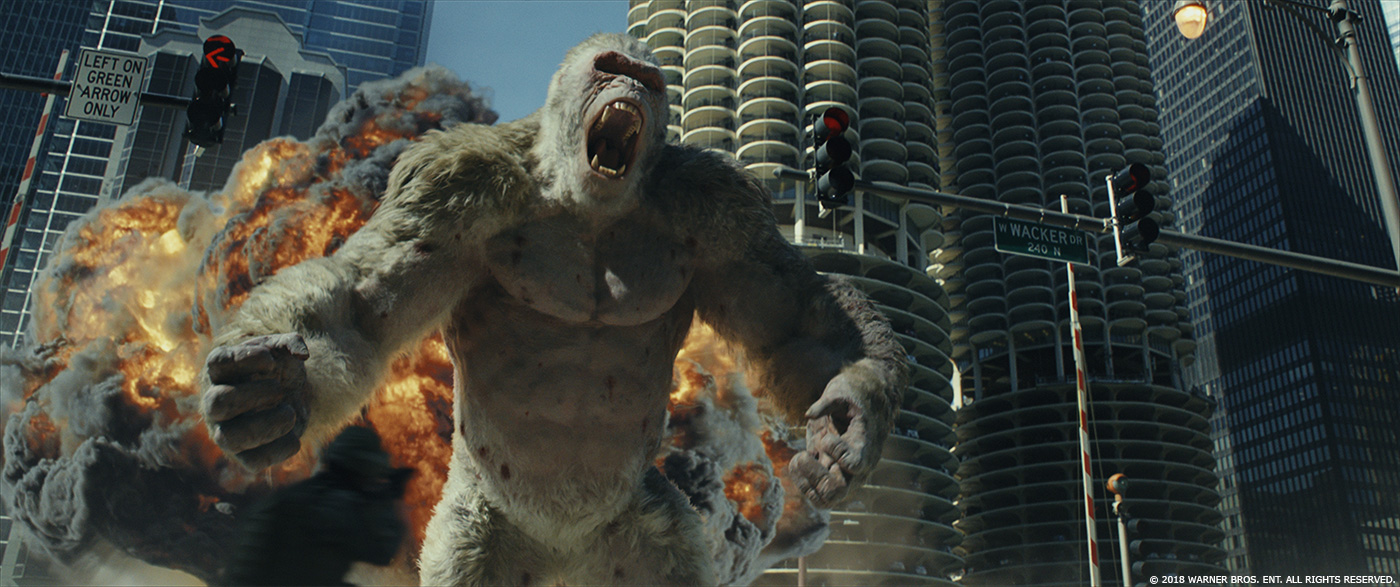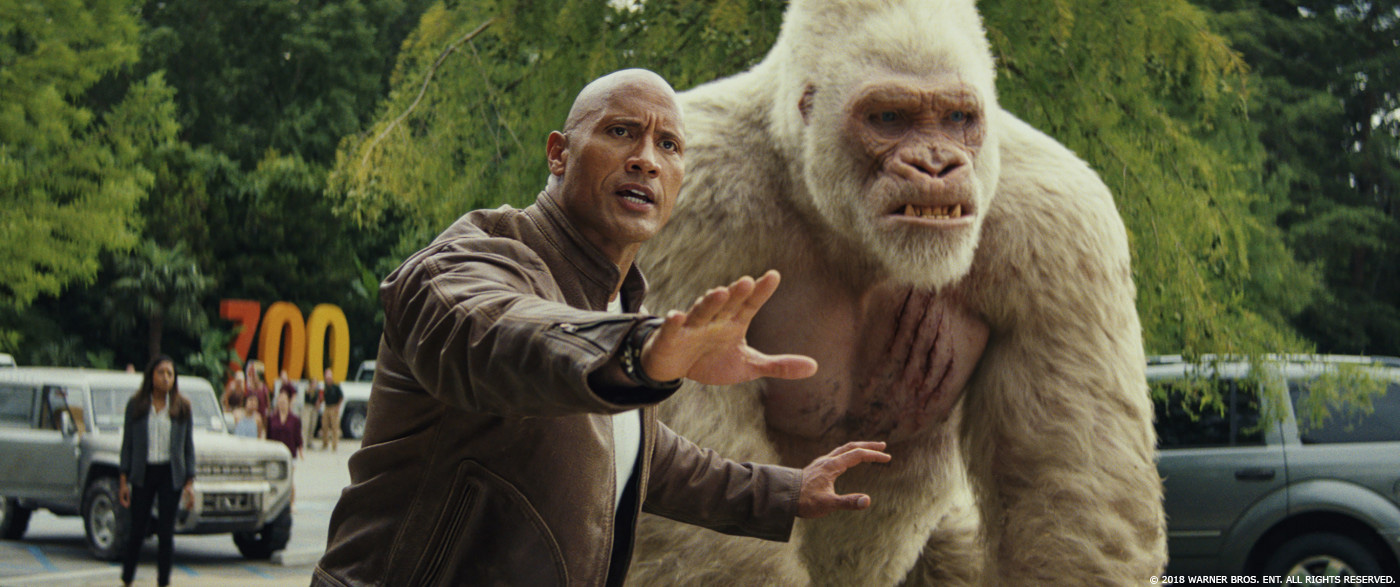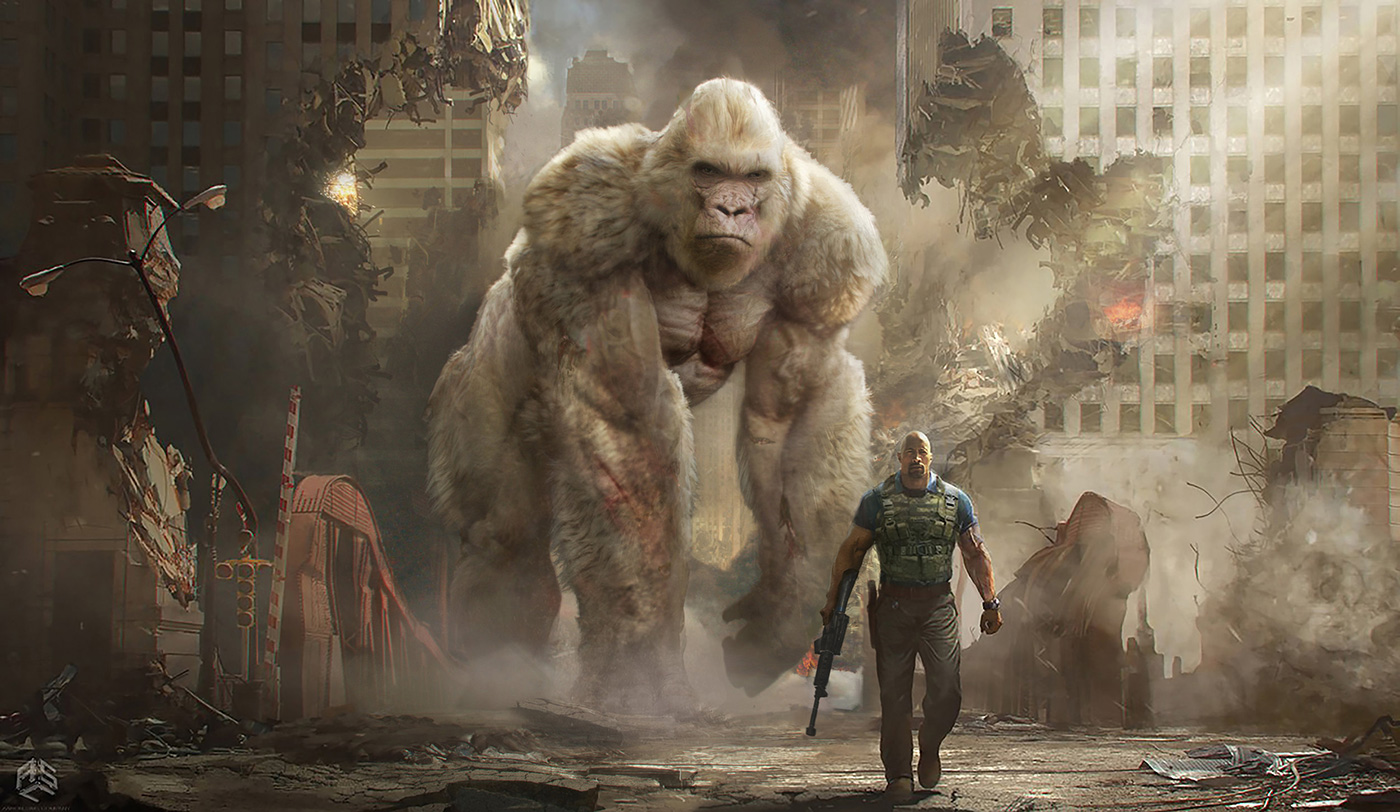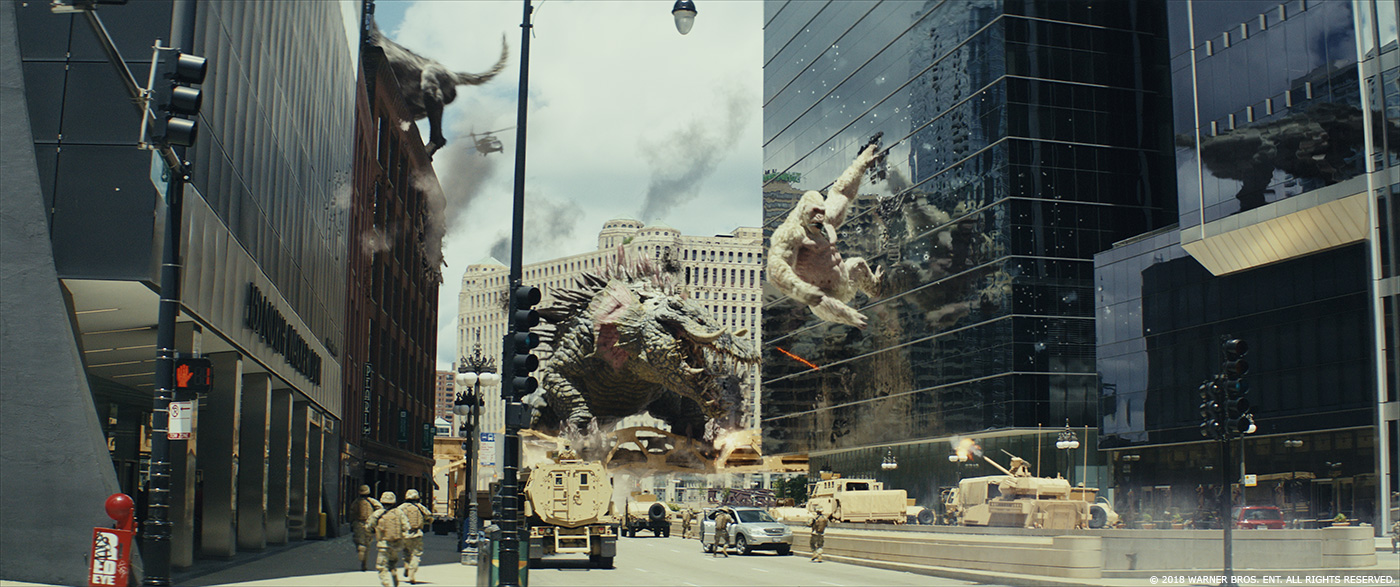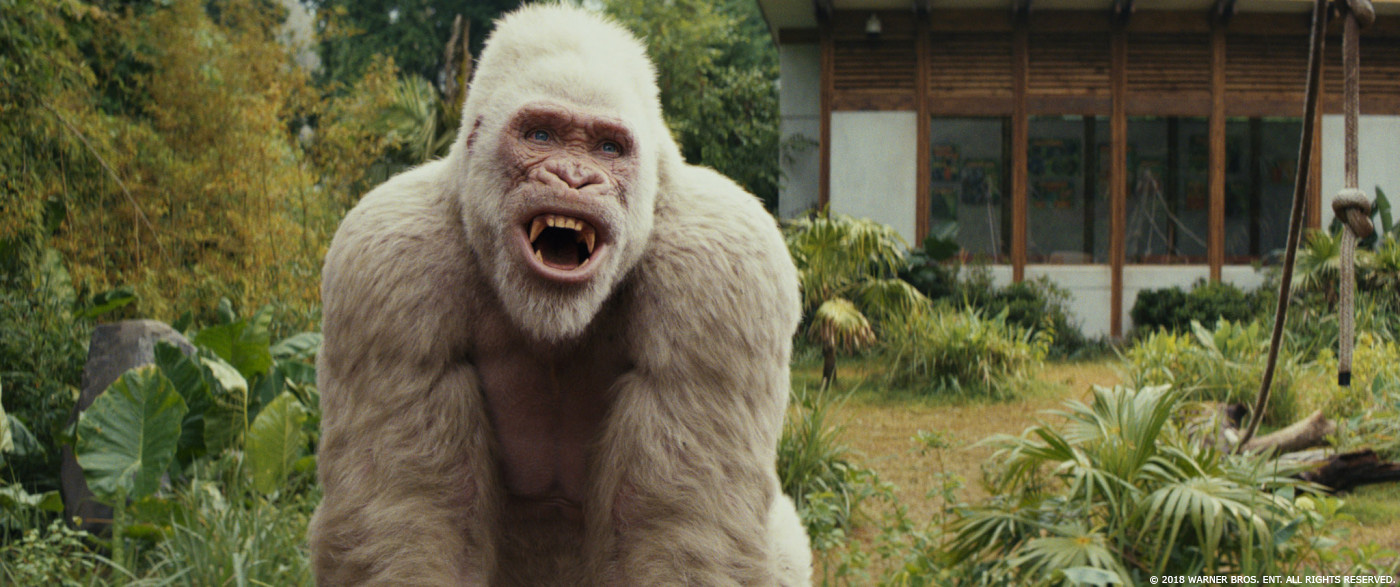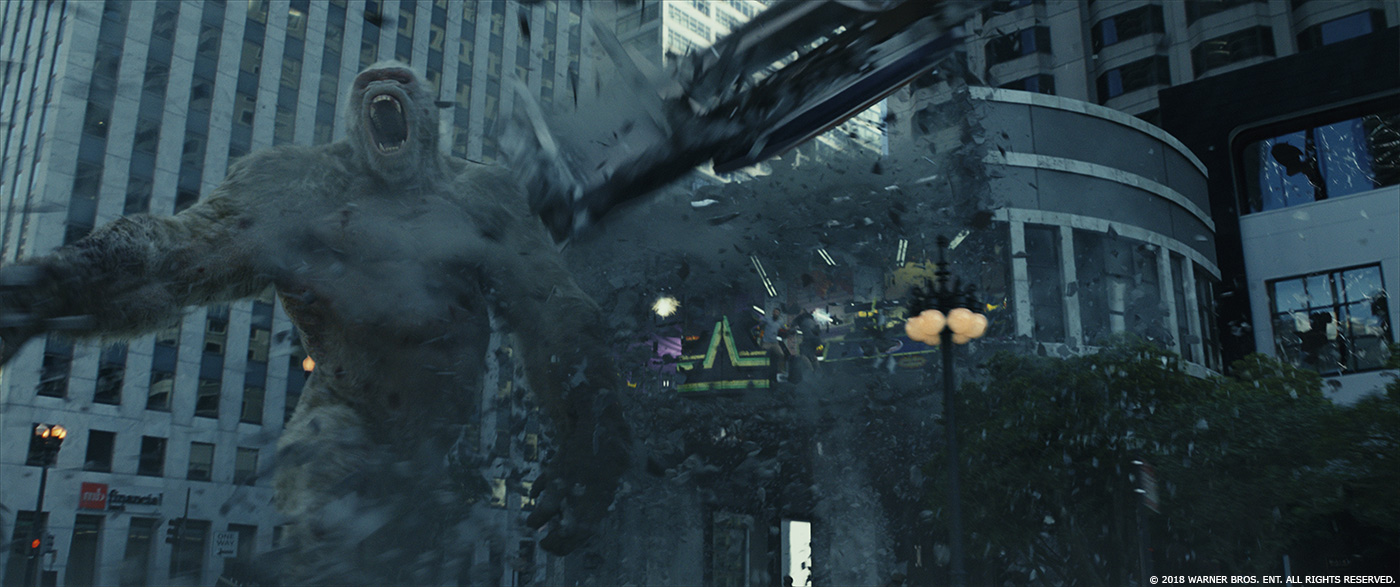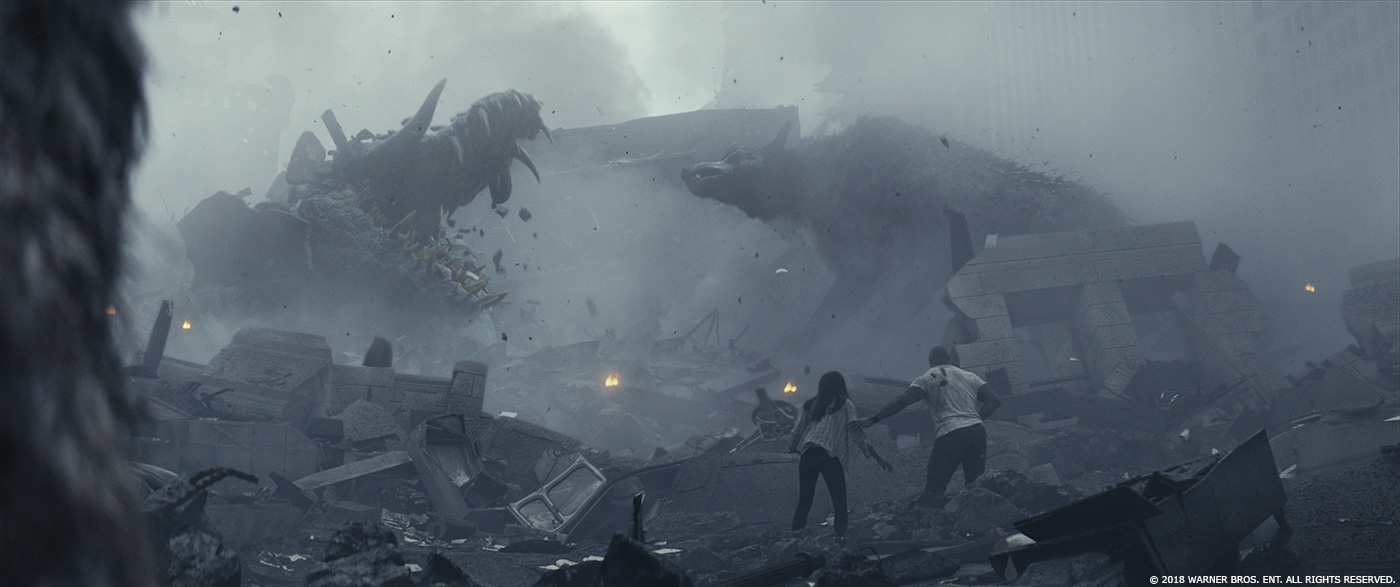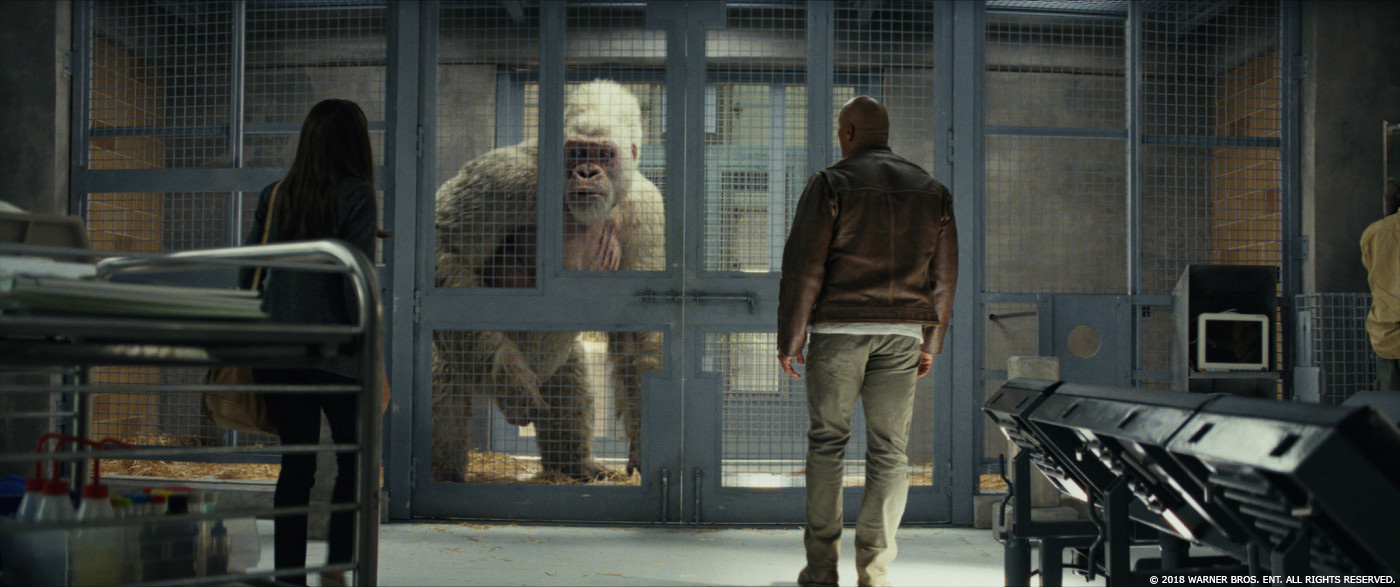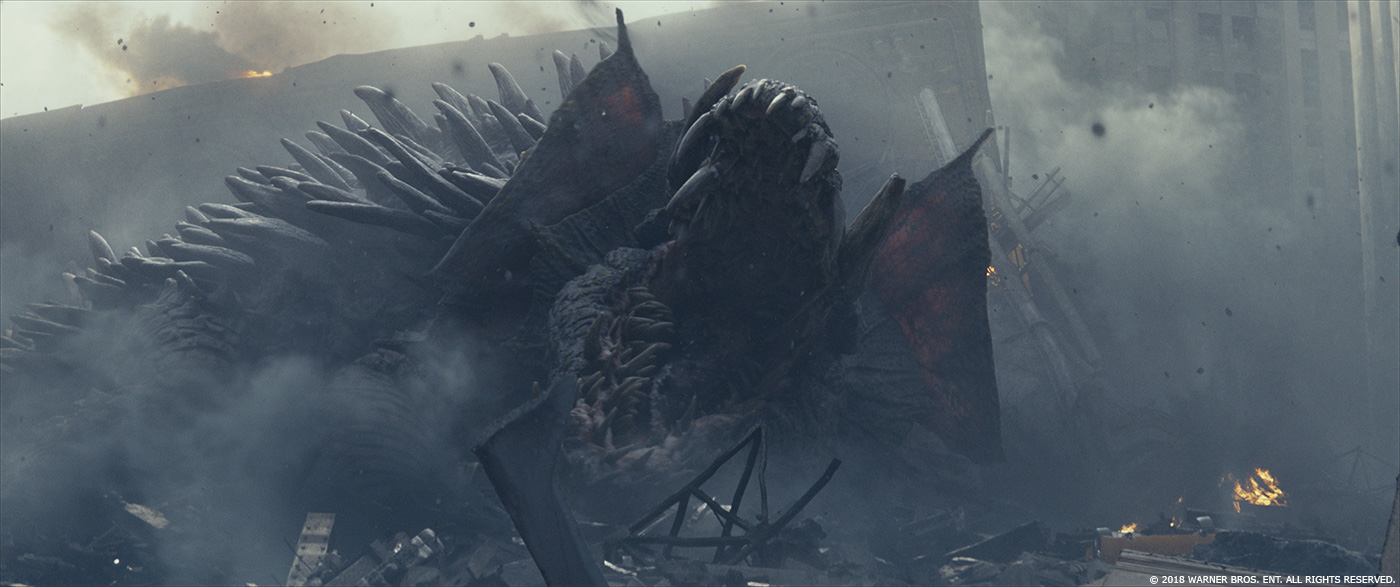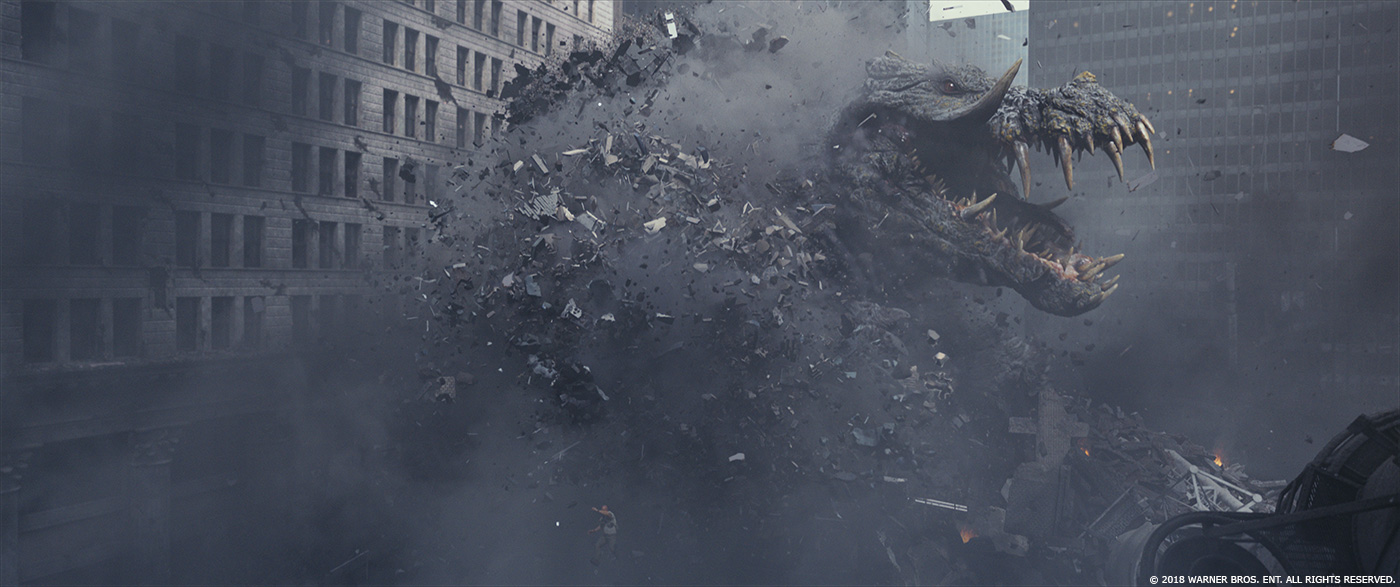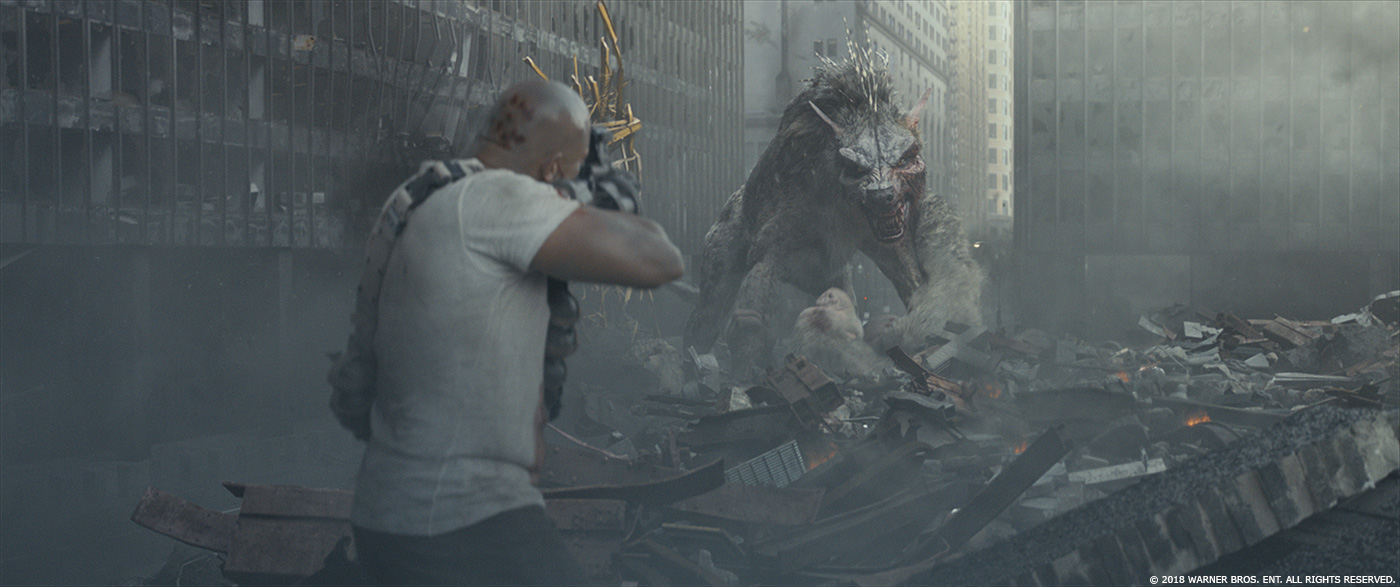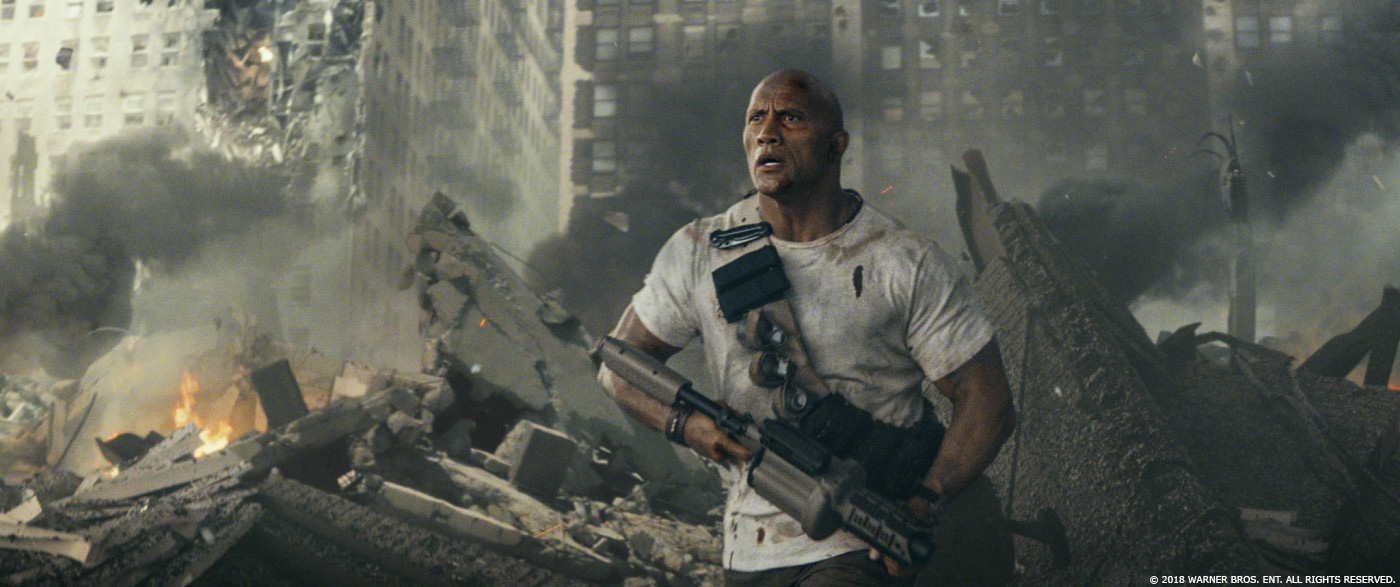In 2017, Erik Winquist had explained the awesome work of Weta Digital on WAR FOR THE PLANET OF THE APES. He talks to us today about the giant creatures of RAMPAGE.
How did you and Weta Digital get involved on this show?
The filmmakers had a project which featured a gorilla who communicates through sign language and has a relationship with Dwayne Johnson’s character that is quite central to the story. The gorilla needed to have a believable on-screen presence for the audience to buy into the film at all, and the obvious approach was to use performance capture. He also becomes monstrous in size by the end of the movie. Between KING KONG and the three recent instalments of the PLANET OF THE APES franchise, as well as THE JUNGLE BOOK, we’ve created several digital primates that positioned us very well for the project. In fact, we were still in the middle of post-production on WAR FOR THE PLANET OF THE APES when this project came to us.
What was your feeling to work with director Brad Peyton and VFX Supervisor Colin Strause?
I met with Brad a few times during principal photography to review our work-in-progress creature builds with him and Colin, but once the shoot was wrapped and we were into post-production, Brad’s time was very much focused on his edit and our reviews were with Colin and his team. By the end, we were having cineSync reviews sometimes twice a day to talk about new submissions and go over Brad’s notes on the previous day’s work.
How did you organize the work with your VFX Producer?
We had just over 650 shots to deliver for this show, almost all of it complex creature work with a fair amount of FX in the mix. So, we split the show into two teams internally to tackle the work efficiently. VFX Supervisors Stephen Unterfranz and Thrain Shadbolt headed up those two teams. Stephen’s team focused their efforts on the Willis Tower collapse and the final showdown in Federal Plaza, which was a full-CG environment, and Thrain’s team looked after all the sequences preceding that, which was quite a broad range of work. That included George before and during his rapid growth, the scene with Ralph in the woods of Wyoming, all the vignettes of Ralph and Lizzie making their way towards Chicago, the interior shots in the cargo plane with George, and the monsters rampaging through the city until they reach the Willis Tower.
You worked on the APES trilogy. How did you used this experience on this movie?
Working on those PLANET OF THE APES films provided us with several years of experience around what makes believable, compelling digital primates. They required us to innovate and devise a functional, effective performance capture pipeline that would go wherever the filmmakers went. This applied both during the shoot and in post-production, where creature rigs, animation approaches, hair grooming tools and rendering strategies were improved upon. All of that gave us a great foundation and experienced crew that are very well versed in making apes. What this film demanded in addition was even greater fidelity in our muscle rigs, and a larger focus on our FX and destruction workflow.
How did you work with the art department to design the animals?
The filmmakers came to us with approved designs for the creatures done by the Aaron Sims Company, and Ralph and Lizzie stay pretty faithful to those designs. Our main design contributions there were around the specifics of the very fine details that the artwork only hints at. George also takes the broad strokes of the muscular nature of his body, the patchiness of his hair, and his smaller skull from the concept artwork. Where we deviated from that was around the character of his face. We created George as a hybrid of two real world gorillas and incorporated some of the facial features of Jason Liles, who plays him via performance capture.
Can you tell us more about their rigging and animation?
Our digital characters all utilise our Tissue system, which is based on a physical simulation of the muscles, using a finite element method approach, as well as driving the outer skin to handle fat jiggle and skin wrinkles on top of it all. But that is just for the body. The facial animation system is a blendshape network, based on a FACS implementation which can further be augmented using tissue to add additional simulated fine wrinkles to areas of soft tissue like the muzzle. These days, our animation puppets are hardware accelerated so that animators can scrub their work in real-time using the high-resolution asset, to be able to judge their work with the highest fidelity.
Did you received specific indications and references for their animations?
Several shots in the film were born from motion studies that our animators invented in the early days of the show. But the film’s action beats were mostly based upon previs that Brad worked out with The Third Floor, with additional post-vis by Proof. Depending on George’s size throughout the film, we took different approaches to his animation. When he’s a regular albino gorilla at the start of the film, we were taking very much the same approach that has worked brilliantly for us on the PLANET OF THE APES films, doing on-set performance capture while the ape performers played in the scene with the other actors. Once George starts growing larger, however, that approach becomes impractical. Even though Jason Liles is quite tall, standing 6’9” (206 cm), he’s still not even close to George by the middle phase of his growth, who stands closer to 12 feet (365 cm) and has an enormous reach. For these moments, some of it is key-framed based on what Jason was doing on the day, but we also did some capture with Jason in more of a traditional mocap stage where he could interact with a scaled representation of the set. By the time George reaches full size towards the end of the film, we almost entirely relied on key-frame animation, and in doing so, the animators looked to footage of gorillas, wolves and crocodiles for inspiration, as well as acting out beats themselves on video. If you look closely, you might even see George dropping a “people’s elbow” on Lizzie’s head, inspired by The Rock’s wrestling days.
George is really expressive. Can you tell us more about his face animations?
It’s a very collaborative effort. Once George’s base facial model was approved, our facial modelers dove into creating all the various shapes that would be needed for the puppet. These form the gorilla equivalent of the FACS shapes that we ran Jason through prior to the shoot. The facial controls in the rig allow the facial animators to either use facial capture data, or keyframe the facial performance manually, based on Jason’s performance. But that’s the key: having an actor working on set with the director to author a performance that has continuity through George’s emotional arc supplies the animators with the performance that Brad is looking to see from George. It’s our job to translate that performance and make sure the right emotional weight of that performance comes through.
The wolf can fly. Can you tell us more about that?
That was an aspect we spent some time scratching our heads about. We looked to animals like sugar gliders and flying squirrels, and in both cases, you see that when they’re not arms outstretched leaping from branch to branch, they have a fair bit of furry skin that bunches up with the membranes that comprise their wings, and we knew we didn’t want that. Ralph only takes flight three times in the movie and we didn’t want all that extra skin flapping around for the rest of his time on screen. The other question was how Ralph could physically even get his legs in a position to have them act like wings. Canine physiology simply isn’t built that way. But we realised after a while that maybe we were overthinking the issue, and that the flying moments are all quite brief. We could achieve this in a very simple way and just cheat it! So, when the wings come out, there’s a simple switch from one regular version of Ralph without wings to a version that had wings. Movie magic.
Can you tell us more about their fur and their skins?
RAMPAGE benefits from recent improvements to our hair fibre shading model, which now models the addition of a central core of the fibre, called the medulla, which is found in animal hair. This was introduced on WAR FOR THE PLANET OF THE APES and it’s resulted in greater consistency in the look of the hair across numerous lighting scenarios.
On the skin side of things, the Tissue system mentioned earlier provides us with dynamic wrinkles and shearing, with extracted displacements and painted fine displacement providing micro detail like pores, and all the intricate fingerprints, calloused skin and scars. We also needed to consider all of the wounds and damage that the characters pick up along the way. Throughout the story, they’re shot at, burned, bitten, bruised and cut, and we needed a damage map to make sure that the appropriate looks were used for each shot. Dozens upon dozens of look variants were created by our Look Development teams based on those maps.
How the huge size of the animals affects the textures and the animation work?
The scale was a definite consideration, as these monsters were going to be seen from quite close distance at times. We spent many months in Look Development making sure that wide views looked like the approved concept art, but that we could get the camera just a few meters from them and the detail would still hold up on camera.
With animation, we were frequently needing to strike the right balance of movement that had sufficient weight to convey their enormous size, but also wasn’t too lethargic. When we took motion appropriate for a normal sized gorilla, wolf or croc and scaled that motion to be appropriate to their scale, Brad typically felt like there wasn’t enough energy to the shot.
How did you handle the various lighting conditions with these animals?
The lighting and environmental conditions were one of the factors that prompted the filmmakers to make George an albino. There was concern that an all-black gorilla might get lost too easily in the action, especially towards the end of the film when the air was heavy with dust and ash from the tower collapse.
What was really helpful to us was the on-set lighting proxies that we had made by our friends next door at Weta Workshop. They fabricated an incredible gorilla head for us, loosely based on the references we were using for George. It was a fibreglass shell with a layer of tinted silicone skin that was airbrushed to an incredible level of detail. He had glass eyeballs and thousands of individually hand-punched white yak hairs, and the final product was taken to Atlanta and we could take that onto set and shoot lighting reference plates with the Alexa motion picture cameras in addition to our usual grey and chrome ball reference. It was a great tool to provide us with a very specific guide for how the scene lighting should play on George from shot to shot, and it also gave the other actors and crew a more consistent picture in their minds of how George was going to look many months down the road.
For Lizzie and Ralph, we also built some lighting reference, but instead of a detailed head, we opted to just make a small square section of some portion of their side, almost as if you cut a chunk out of each of them and mounted it to a stick. Lizzie had very detailed sculpted scutes and spikes and the whole piece was painted with representative colour scheme of greens and reds. Meanwhile, Ralph was made with tinted silicone skin, airbrushed to hint at the tough rhino like skin he would have, with hand punched hair and porcupine quills.
We then also built digital versions of those proxies, and our lighters were able to pull those into their scenes and get their image-based lighting set up so that the digital proxies matched the on-set lighting reference in the plates. Once we had a match, we knew that the foundation was solid. From there, the lighters would make adjustments to beauty light the monsters to make the shots really sing.
How did you work with the SFX and stunt teams for the animals interactions on the set?
The big stunt rigging moment in the film happens as George breaks out of his cage and starts throwing federal agents around the interior of the C-17 cargo plane. Stunt coordinator Allan Poppleton and his team took The Third Floor previs and reworked the beats a little to something that they could achieve with wire work choreography. The primary stunt shot in that sequence is about 500 frames long and has George bounding and swinging all over the plane, taking out agents along the way. The shot was photographed as two parts, which we stitched together into a seamless single take by removing the stunt rigging, applying a little bit of re-speeding, adding muzzle flashes, sparks and falling debris to arrive at the final shot you see in the film. For this sequence, Special FX supervisor JD Schwalm provided, among other things, spark hits and CO2 blasts as well as rigging the massive C-17 set on airbags to add sway from turbulence during the chaotic sequence.
The final act takes place in Chicago. How did you recreated the city?
The beauty of this film was that we had to recreate very little of the city. The production hired accomplished aerials pilot Fred North with aerial DP Dylan Goss, who got some amazing shots of the city for us to put our monsters into. All the rampaging shots through Chicago were plate shots that we added occasional partial building sections and matte painted damage to where necessary.
We built a very detailed full digital replica Willis Tower (a.k.a. Sears Tower) from the inside out, based upon historic photographs of its construction and any bits of building schematics we could get our hands on. We were going to have Lizzie going right through the middle of the building, so needed to have meaningful structure behind the outer façade to be torn apart as she makes her way through.
After the skyscraper comes crashing down into Federal Plaza, however, everything you see is full-CG, due to the utter damage that is sustained by the plaza and surrounding buildings. The destruction is so extensive that there just wouldn’t be any value to using plates, as we’d have had to replace everything in them. We referenced lots of imagery from the September 11, New York World Trade Centre attacks as well as looking at earthquake damaged buildings in Wellington where we’re based to inform the look of the damaged buildings in the plaza.
George is fighting the other animals. How did you created the choreography of this fight?
Much of the choreography for the fight came from The Third Floor previs, but in the course of production, our animators also came up with gags and little vignettes that made their way into the sequence.
In Chicago, the animals are causing massive destructions. How did you handle these simulations?
Johnathan Nixon, our FX supervisor, and his team spent a lot of time early on working with Nick Gaul and his models team to ensure that while we were building the architectural assets, that they were being built for destruction. We tagged building materials, so that iron and steel, concrete, glass, plaster and wood could be handled by the destruction simulations appropriately. The sims themselves were all run in Houdini, using art directable pre-fracturing techniques and secondary emission criteria to generate smaller chunks of brick and other building matter. Our in-house Synapse solver was also used to create 1,000-frame long fluid sims to populate all the dense pyroclastic-like clouds of dust and ash from the collapse.
These shots have huge amount of datas (character, fur, destructions, …). How did you prevent your render farm to don’t burn?
The heaviest thing for us to work through by far was the Federal Plaza digital environment. What remained after the tower collapse was an enormous debris field made up of destroyed sections of the surrounding buildings. In all, the wreckage was made up from over 250 individual high res debris assets, and through instancing, we created a destroyed wasteland of more than 1 million pieces of debris. In addition to the debris piles, our compositing team, led by Compositing Supervisors Ben Warner and Giuseppe Tagliavini, populated the environments with a combination of rendered and practical dust, smoke, fire and falling ash and papers.
Which sequence or shot was the most complicated to create and why?
The Federal Plaza sequence presented us with the greatest challenge, both from the number of assets that were required to build for it and the complexity of those shots, but also from a scheduling perspective. That scene was the last to be shot in Atlanta and it was the last to be turned over. It was also our single largest sequence, coming in at around 250 shots.
What is your favorite shot or sequence?
Our first and last sequences in the film take that honour. The first, being the zoo scene where we first meet George, because it’s a genuinely endearing scene and sets up the whole central relationship between Davis and George that the film relies on. The last, being the final showdown in Federal Plaza because it’s a really engaging action sequence that’s notably well-choreographed and quite exciting to watch. And it looks fantastic!
What is your best memory on this show?
There were many, but turning up in Atlanta and seeing Jason Liles working with Terry Notary for the first time was a real kick, because it showed me that the production had found a great performer to play our lead character. Seeing the first epic water simulations of Lizzie in the Chicago river was also pretty electrifying, as were those moments when everything clicked on our shots in the Federal Plaza. When George smashes Lizzie with the construction crane, and the atmosphere is playing beautifully with the sun backlighting it… that stuff is magic.
How long have you worked on this show?
We really got going in earnest on creature builds from about early March 2017 and our last few shots were finaled in the first week of March this year, so it was basically one year of production time for us.
What’s the VFX shots count?
Our final count was 652 shots, the bulk of which were creature shots.
What was the size of your team?
Over the course of the production, over 650 crew members contributed to the show in one way or another. That’s pretty wild!
What is your next project?
Right now, I’m focusing on a project called “my European holiday”. It’s time for a bit of a break!
A big thanks for your time.
// WANT TO KNOW MORE?
Weta Digital: Dedicated page about RAMPAGE on Weta Digital website.
© Vincent Frei – The Art of VFX – 2018


